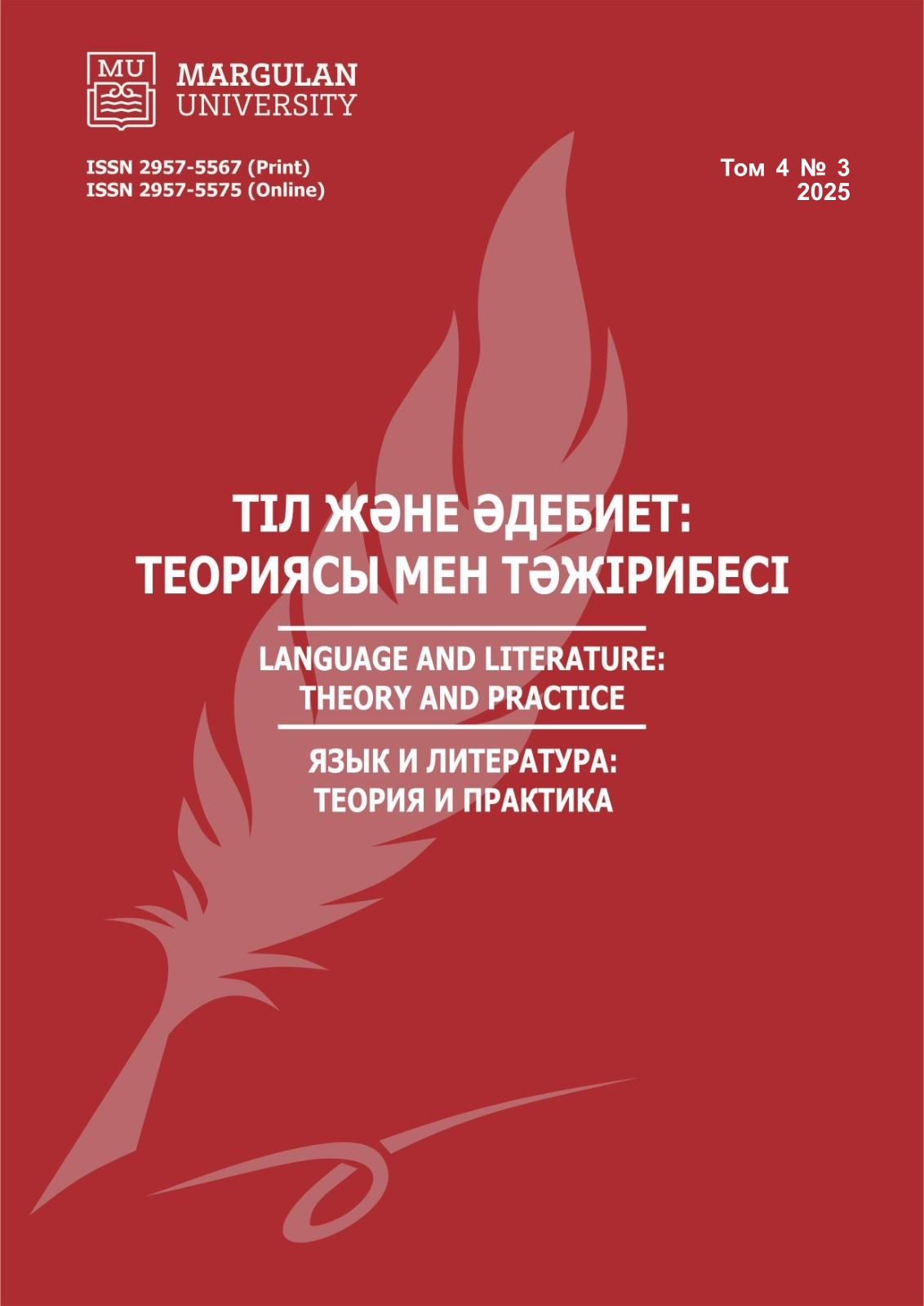THE WORD-FORMATION FUNCTION OF ETHNIC AND BORROWED CONCEPTS IN THE KAZAKH LANGUAGE
Аңдатпа
DOI:
https://doi.org/10.52301/2957-5567-2025-4-3-108-125Keywords:
recipient, ethnic and borrowed concepts, word-formation mechanism, conceptual identityAbstract
The article examines the significance of ethno-, borrowed concepts in the word formation of the Kazakh language. The purpose of the article is to determine that concepts are the main word–formation mechanism of derivatives. The principles of word formation are considered, the features of concepts, the recognition of ethno-, borrowed concepts in the recipient's language are indicated. The perception of ethnic concepts, the difference between borrowed concepts, borrowed words, the reasons for partial or complete translation of borrowed words, translatable, untranslatable borrowed words, and conceptual correspondence are analyzed. The perception of ethnic concepts in the recipient's language is explained. Results of the article: concepts clarify the etymology of words; the word-formation model is determined; both ethno- and borrowed concepts are the main word-formation mechanisms when naming the genetics of words. The article uses generalizing, comparative, comparative-semantic, conceptual and cognitive methods.
References
Baıtursynov A.(1992).Til taǵylymy [Language learning].Almaty:Ana tili. (in Kaz.).
Jubanov Q.(2013).Qazaq til biliminiń máseleleri. [Problems of knowledge of the Kazakh language] Almaty. Abzal-Aı (in Kaz.).
Bokýleva B.S.(2013).Kirme sózder – mádenı aqparat saqtaýshy fenomen [Borrowed words are a phenomenon that stores cultural information]//QazUý habarshysy.Shyǵystaný serıasy.№3(64).64-68.(in Kaz.)
Vinogradov V.V.(1953) Osnovnyye tipy leksicheskikh znacheniy slova[Vinogradov V.V. Basic types of lexical meanings of a word//Problems of linguistics]//Voprosy yazykoznaniya. M.:AN SSSR. Inst.yazykoznaniya.– 160 s(in Russ.).
Isaev S.(1998).Qazirgi qazaq tilindegi sózderdiń gramatıkalyq sıpaty[Grammatical characteristics of words in the modern Kazakh language]7 Almaty: Raýan (in Kaz.).
Kalashnikov M.V(2015.).Ideologema. Kontsept? Ponyatiye!(K voprosu o minimal'noy znachimoy yedinitse issledovaniya v ramkakh istoriko-semanticheskogo analiza [Ideologeme. Concept? Notion! (On the issue of the minimum significant unit of research within the framework of historical-semantic analysis]//«Steny i mosty»–III: istoriya vozniknoveniya i razvitiya idei mezhdistsiplinarnosti: materialy mezhdunarodnoy nauchnoy konferentsii.Tsentr mezhdistsiplinarnykh gumanitarnykh issledovaniy RGGU. M.:Akademicheskiy proyekt; Gaudeamus. S.:124-134 (in Russ.).
Lakoff Dzh., Dzhonson M.(2004.) Metafory, kotorymi my zhivem [Metaphors We Live By]. Perevod s angliyskogo (pod red. A.N.Baranova) . M.: Editorial URSS.(in Russ.).
Nıazǵalıeva A.Á. (2009). Qazaq sóılenisterindegi kirme sózderdiń zerttelýi[Study of loanwords in Kazakh speech]//QR ǴA Habarshysy.Fılologıa serıasy №1. 28-33 b.(in Kaz.).
Oralbaı N.(1989). Tildiń sózjasam júıesi//Qazirgi qazaq tiliniń sózjasam júıesi [The word-formation system of the language]. Almaty: «Ǵylym». 8-20-b. (in Kaz.).
Potebnya A.(1989).Mysl' i yazyk //Slovo i mif [Thought and language//Word and myth]. M.: «Pravda».(in Russ.).
Soldatkina T.A.(2013.)Osnovnyye ponyatiya angliyskogo i frantsuzskogo paremiologicheskogo fonda[Basic concepts of the English and French paremiological fund] //Sovremennyye problemy nauki i obrazovaniya (setevoye izdaniye). No.6.(in Russ.).
Suleymenov O.(1998).Yazyk pis'ma[Writing language.].Almaty-Rim.(in Russ.).
Tsaturyan M.M., Matevosyan A.P.(2023.). Nauchnyye kontseptsii zaimstvovaniya yazyka// Sovremennaya nauka: aktual'nyye problemy teorii i praktiki [Scientific concepts of language borrowing]. Seriya gumanitarnyye nauki.No.6.192-196. . (in Russ.).
Duisenberg, M. (2020). Linguistic landscape: a cross cultural perspective. Linguistics and Culture Review, 4(1), 15-28. https://doi.org/10.21744/lingcure.v4n1.
Han J.(2020). Exploring the translation model of poetic metaphor based on conceptual integration theory. Journal of Literature and Art Studies, 10(2), 136–145.
Temirgazina, Z., Nikolaenko, S., Akosheva, M., Luczyk, M., & Khamitova, G. (2020). Naive anatomy in the Kazakh language world picture in comparison with English and Russian. XLinguae, 13(2), 3–16. https://doi.org/10.18355/XL.2020.13.02.01
Zayrova, K. M (2022).Ethnokulturelle Charakterisierung der Kleidungsbezeichnungen in der Karakalpak-Sprache //Berlin Studies Transnational Journal of Science and Humanitiesces. ISSN 2749-0866 Philological sciences.Vol.2. – No.1.6.125-132. http://berlinstudies.de/
Downloads
Published
How to Cite
Issue
Section
License
Copyright (c) 2025 Ы. Шакаман, А. Кок

This work is licensed under a Creative Commons Attribution-NonCommercial-NoDerivatives 4.0 International License.
https://creativecommons.org/licenses/by-nc/4.0/deed.en


